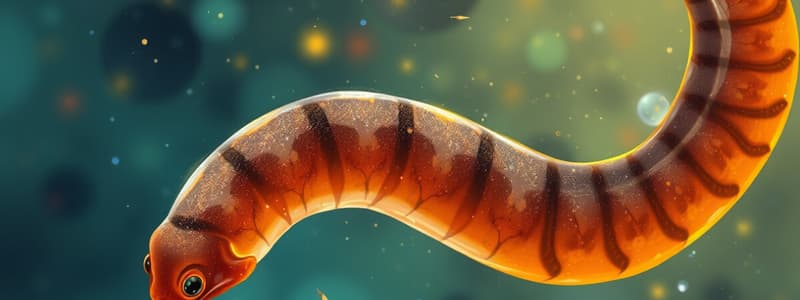Podcast
Questions and Answers
The Phylum Platyhelminthes consists of?
The Phylum Platyhelminthes consists of?
Flatworms
Which of the following are characteristics of Phylum Platyhelminthes? (Select all that apply)
Which of the following are characteristics of Phylum Platyhelminthes? (Select all that apply)
- Acoelomate (correct)
- Triploblastic (correct)
- Bilateral symmetry (correct)
- Cylindrical body
What does cephalized mean?
What does cephalized mean?
Has a head region
Main characteristics of Platyhelminth bauplan?
Main characteristics of Platyhelminth bauplan?
What are cerebral ganglion?
What are cerebral ganglion?
What are protonephridia?
What are protonephridia?
The body wall of Platyhelminthes consists of?
The body wall of Platyhelminthes consists of?
Platyhelminthes bodies are covered in cilia.
Platyhelminthes bodies are covered in cilia.
The nervous system in Platyhelminthes is structured like a ladder.
The nervous system in Platyhelminthes is structured like a ladder.
What types of muscles are present in the mesoderm of Platyhelminths?
What types of muscles are present in the mesoderm of Platyhelminths?
Endoderm in Platyhelminths typically has?
Endoderm in Platyhelminths typically has?
What do nephridiopores do?
What do nephridiopores do?
Nervous system and sense organs of Platyhelminths consist of?
Nervous system and sense organs of Platyhelminths consist of?
Retinular cells can sense what?
Retinular cells can sense what?
What are rheoreceptors?
What are rheoreceptors?
What do chemoreceptors sense?
What do chemoreceptors sense?
Class Turbellaria is characterized by?
Class Turbellaria is characterized by?
Order Acoela under Class Turbellaria has?
Order Acoela under Class Turbellaria has?
Order Polycladida is known for?
Order Polycladida is known for?
Class Cestoda is commonly referred to as?
Class Cestoda is commonly referred to as?
Class Cestoda characteristics include?
Class Cestoda characteristics include?
What does hermaphroditic condition mean?
What does hermaphroditic condition mean?
Class Monogenea is characterized by?
Class Monogenea is characterized by?
What is the life cycle of Trematodes?
What is the life cycle of Trematodes?
Schistosoma mansoni is known to cause?
Schistosoma mansoni is known to cause?
Schistosomiasis can cause?
Schistosomiasis can cause?
What does Class Cestoda include?
What does Class Cestoda include?
Taenia saginata are passed through?
Taenia saginata are passed through?
Study Notes
Phylum Platyhelminthes Overview
- Comprised of flatworms, known for their flattened body shape.
Characteristics of Platyhelminthes
- Triploblastic: three germ layers (ectoderm, mesoderm, endoderm).
- Acoelomate: lack a body cavity.
- Exhibits spiral cleavage during embryonic development.
- Contains a sac-like gut for digestion.
- Cephalization present, with a distinct head region.
- Displays bilateral symmetry, flattened dorsoventrally.
- Protonephridia function as a primitive excretory system.
- Includes both parasitic and free-living species.
- Primarily hermaphroditic, possessing both male and female reproductive structures.
Structural Features
- Cerebral ganglion serves as a simple neural aggregation, functioning like a brain.
- Protonephridia function in excretion, resembling a basic kidney system.
- Body wall consists of epidermis, basement membrane, mesoderm, gland cells, and rhabdoids, providing structure and function.
- Bodies are covered with cilia aiding in locomotion and feeding.
- Nervous system designed like a ladder, also includes nerve cords and ganglia.
Mesoderm and Endoderm
- Mesoderm in Platyhelminths includes circular, diagonal, longitudinal, and dorsoventral muscle fibers aiding movement.
- Endodermal structure features a single cell layer, phagocytic cells, enzymatic glands, and can exhibit extracellular digestion.
Nephridiopores
- Structures that excrete waste water, functioning similarly to urine in higher organisms.
Sensory Organs
- Retinular cells detect light intensity, though they do not form images.
- Rheoreceptors sense mechanical stimuli in the environment.
- Chemoreceptors detect chemical signals, aiding in food detection and predator avoidance.
Classifications within Phylum Platyhelminthes
-
Class Turbellaria:
- Primarily free-living aquatic organisms with a ciliated epidermis.
- Includes taxa such as Order Acoela (no permanent digestive cavity) and Order Polycladida (branched gut).
-
Class Monogenea:
- Ectoparasitic organisms with a life cycle in one host, featuring specialized attachment structures.
-
Class Trematoda:
- Endoparasitic species with complex life cycles involving multiple hosts.
- Notable examples include Paragonimus westermani (Japanese lung fluke) and Schistosoma mansoni, which causes schistosomiasis.
-
Class Cestoda:
- Known for flat, ribbon-like form and absence of a digestive system, with the anterior scolex for attachment.
- Includes Taenia saginata (beef tapeworm), transmitted through proglottids in feces.
Health Implications
- Schistosomiasis causes severe outcomes such as diarrhea, abdominal pain, liver damage, and impaired growth due to infection from schistosome species.
- Hosts for schistosomes include snails with a skin-penetrating free-living stage.
Reproduction
- Hermaphroditic condition allows for both male and female gamete production, enhancing reproductive success in various environments.
Studying That Suits You
Use AI to generate personalized quizzes and flashcards to suit your learning preferences.
Description
This quiz provides flashcards covering essential aspects of the Phylum Platyhelminthes, commonly known as flatworms. Explore their characteristics, structure, and classification. Ideal for students studying invertebrate zoology or related fields.




